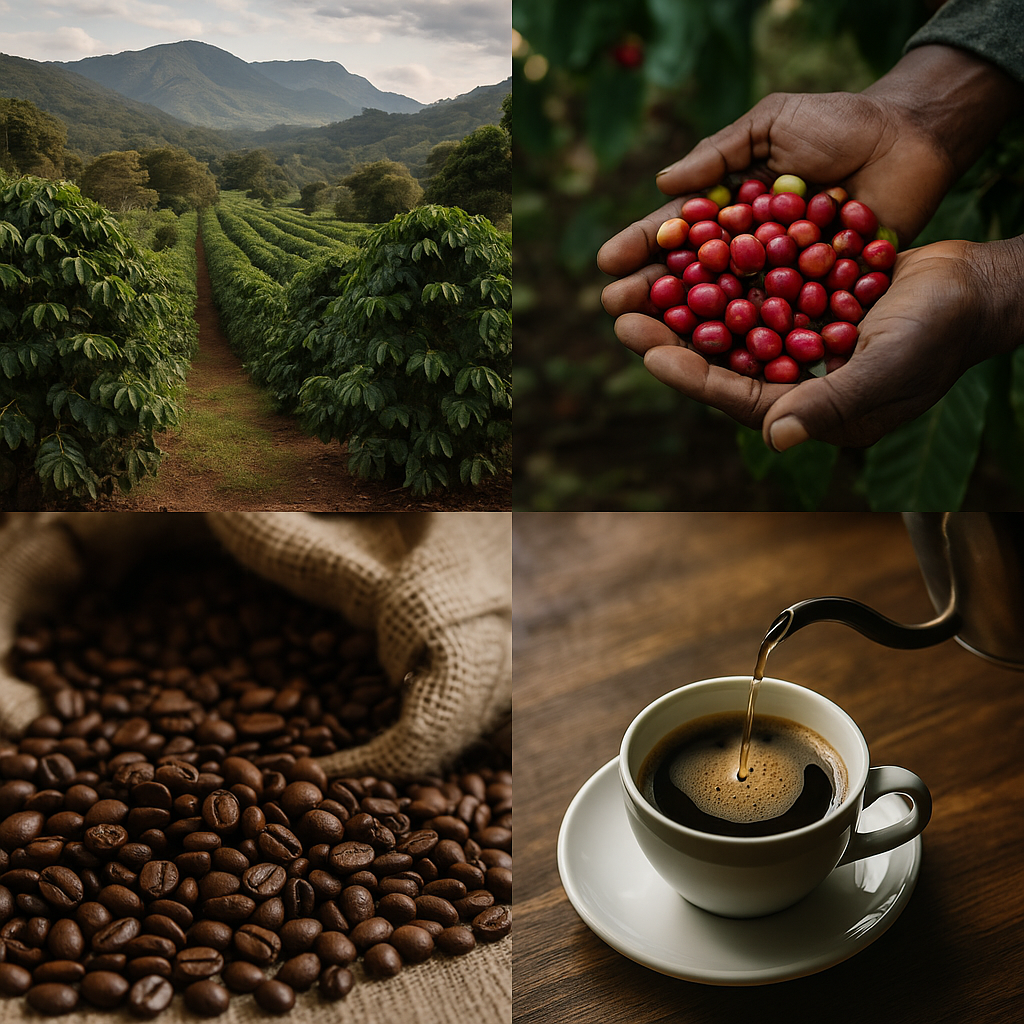Have you ever paused to wonder how the rich, aromatic coffee in your mug arrived there? That moment of comfort in your kitchen, that caffeine kick before work—it all begins thousands of miles away, on misty mountain farms and under tropical canopies.
The journey from bean to cup is long, complex, and fascinating. Every stage, from cultivation to roasting and brewing, shapes the final flavor in your cup. In this article, we invite you to trace the remarkable path coffee takes—from a seed planted in remote soil to the steaming cup in your hands.
Where It All Begins: The Coffee Farm
The journey starts with the coffee tree, a tropical plant that grows best at high altitudes with stable temperatures, ample rainfall, and rich soil. The two most cultivated species are Arabica (known for its fine acidity and complex flavors) and Robusta (stronger, more bitter, and higher in caffeine).
Coffee is grown in over 70 countries, forming what’s known as the “coffee belt”—regions near the equator including Brazil, Colombia, Ethiopia, Vietnam, and Kenya. Each location contributes its own “terroir,” influencing flavor through climate, altitude, and soil.
Did you know?
It takes three to four years for a coffee tree to produce its first usable harvest. And a single tree yields enough beans for just one to two pounds of roasted coffee per year.
The Art of Harvesting
Coffee cherries ripen at different times, making harvesting a meticulous task. In specialty coffee production, the cherries are often picked by hand—ensuring only the ripest fruit is selected. This method is labor-intensive but critical for achieving high quality.
In some large farms or flat regions, mechanical harvesting is used. While more efficient, it often sacrifices precision.
Once picked, the clock starts ticking—coffee must be processed quickly to preserve freshness.
Processing: Turning Cherries into Beans
Processing separates the coffee bean (the seed) from the cherry. There are several main methods, each affecting flavor:
- Washed (Wet) Process: The outer pulp is removed with water and the beans are fermented, resulting in clean, bright, and acidic profiles.
- Natural (Dry) Process: Cherries are dried whole in the sun before hulling. This method enhances sweetness and fruity complexity.
- Honey Process: A hybrid method where some mucilage is left on the bean during drying, creating balance and body.
Drying follows, often on raised beds or patios. Beans must be dried to 10–12% moisture, then rested before the next step.
Milling and Grading
Once dried and rested, the beans go through hulling (removal of parchment or husk) and grading, where they are sorted by size, density, and defects.
Specialty coffees are carefully evaluated, with only the best beans moving forward. Defective beans—damaged by insects, fermentation, or overripe picking—are removed, as they negatively affect taste.
Then, the green beans are packed into bags (often made of jute or GrainPro) and prepared for export.
The Global Journey: Export and Import
Coffee is one of the most traded commodities in the world. After milling, green beans are shipped in containers across oceans to roasteries in consumer countries. Brazil, the world’s top producer, exports coffee to over 100 countries.
At this stage, the beans are still raw and flavorless—roasting will unlock their potential.
Roasting: Science Meets Art
Roasting is where the magic happens. Through heat, coffee beans undergo chemical changes known as the Maillard reaction and caramelization, developing flavor, aroma, and color.
Roasters determine the profile based on:
- Origin and variety
- Desired flavor (light, medium, or dark roast)
- Brew method target (espresso vs. filter)
Light roasts highlight origin flavors (fruity, floral), while dark roasts bring out caramelized, bitter-sweet notes. Roasting is part science, part instinct—and key to delivering the taste intended by farmers and processors.
Packaging and Freshness
Once roasted, coffee begins to lose its freshness rapidly. That’s why packaging is crucial. High-quality coffee is often sealed in valve bags that let CO₂ out but block oxygen.
You might see roast dates on specialty coffee bags—a sign the brand values transparency and flavor.
For optimal taste, coffee should be used within two to four weeks of roasting, depending on storage.
Grinding and Brewing: The Final Stage
Finally, the beans reach you—the home barista. But the journey isn’t over. Grind size, water quality, temperature, and brew method all play crucial roles in unlocking the coffee’s full character.
Popular methods include:
- Pour-over (e.g., V60, Chemex) for clarity and brightness
- French press for richness and body
- Espresso for intensity and complexity
- Cold brew for a smooth, sweet extraction
- Moka pot for strong, stovetop flavor
Each method highlights different aspects of the coffee—and personal preference becomes the final guide.
Final Thoughts: More Than Just a Drink
From bean to cup, coffee’s journey spans continents, cultures, and countless hands. Behind your daily brew are farmers, pickers, processors, roasters, and transporters—each playing a vital role in delivering that perfect sip.
Understanding this process deepens our appreciation for coffee and reminds us that every cup tells a story—not just of flavor, but of people, land, and craftsmanship.
So the next time you make your morning coffee, pause for a moment. Think of the journey it took to reach you. And savor it—not just with your palate, but with respect and curiosity.
